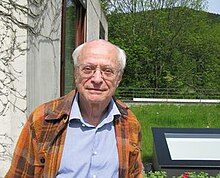Jean-Pierre Serre
| Jean-Pierre Serre | |
|---|---|
 |
|
| Born |
15 September 1926 Bages, Pyrénées-Orientales, France |
| Residence | Paris, France |
| Nationality | French |
| Fields | Mathematics |
| Institutions |
Centre National de la Recherche Scientifique Collège de France |
| Alma mater |
École Normale Supérieure University of Paris |
| Doctoral advisor | Henri Cartan |
| Doctoral students |
Michel Broué John Labute Jean-Marc Fontaine |
| Notable awards |
Fields Medal (1954) Balzan Prize (1985) CNRS Gold medal (1987) Steele Prize (1995) Wolf Prize in Mathematics (2000) Abel Prize (2003) |
Jean-Pierre Serre (French: [sɛʁ]; born 15 September 1926) is a French mathematician who has made contributions to algebraic topology, algebraic geometry, and algebraic number theory. He was awarded the Fields Medal in 1954, the Wolf Prize in 2000 and the Abel Prize in 2003.
Born in Bages, Pyrénées-Orientales, France, to pharmacist parents, Serre was educated at the Lycée de Nîmes and then from 1945 to 1948 at the École Normale Supérieure in Paris. He was awarded his doctorate from the Sorbonne in 1951. From 1948 to 1954 he held positions at the Centre National de la Recherche Scientifique in Paris. In 1956 he was elected professor at the Collège de France, a position he held until his retirement in 1994. His wife, Professor Josiane Heulot-Serre, was a chemist; she also was the director of the Ecole Normale Supérieure de Jeunes Filles. Their daughter is the former French diplomat, historian and writer Claudine Monteil. The French mathematician Denis Serre is his nephew.
From a very young age he was an outstanding figure in the school of Henri Cartan, working on algebraic topology, several complex variables and then commutative algebra and algebraic geometry, where he introduced sheaf theory and homological algebra techniques. Serre's thesis concerned the Leray–Serre spectral sequence associated to a fibration. Together with Cartan, Serre established the technique of using Eilenberg–MacLane spaces for computing homotopy groups of spheres, which at that time was one of the major problems in topology.
...
Wikipedia
